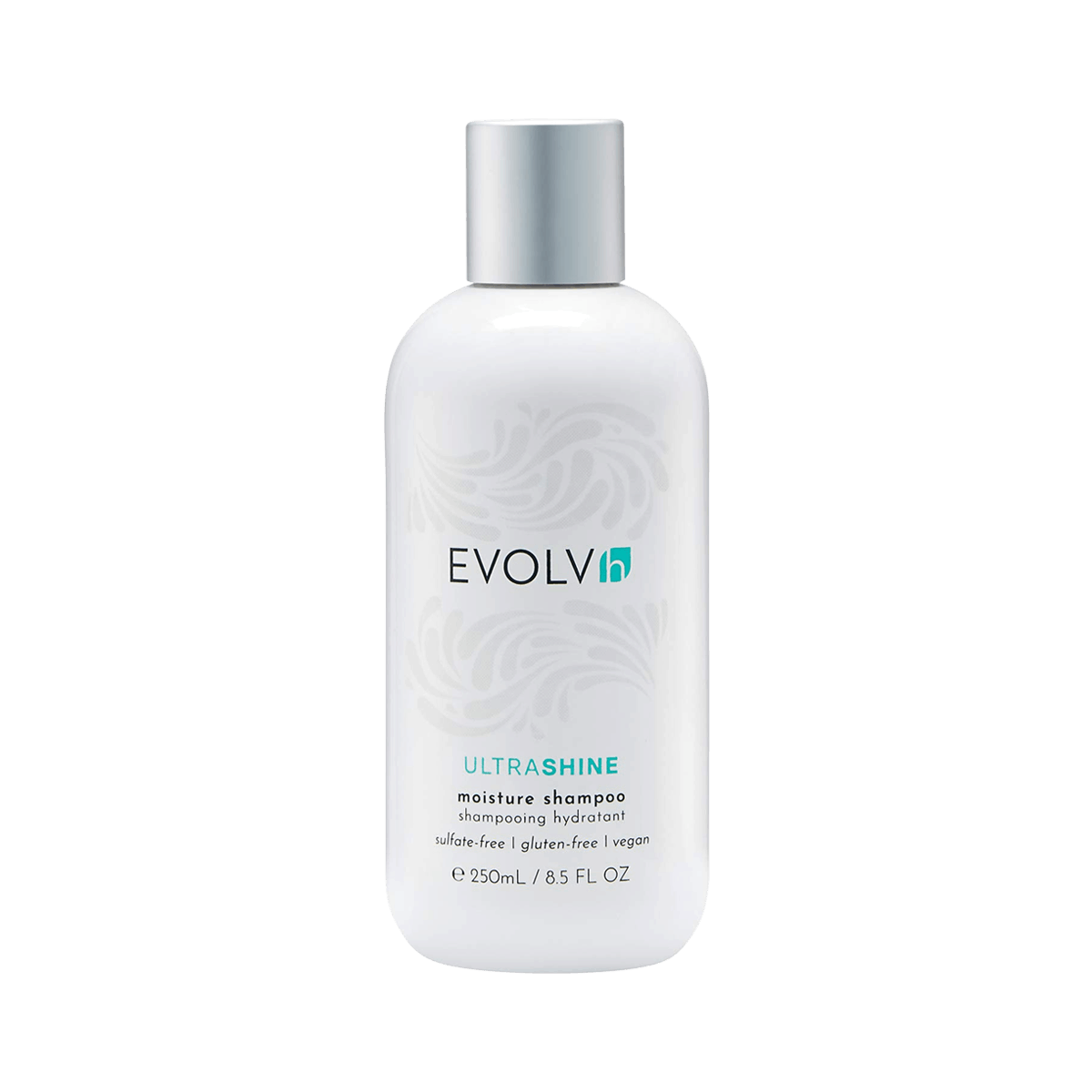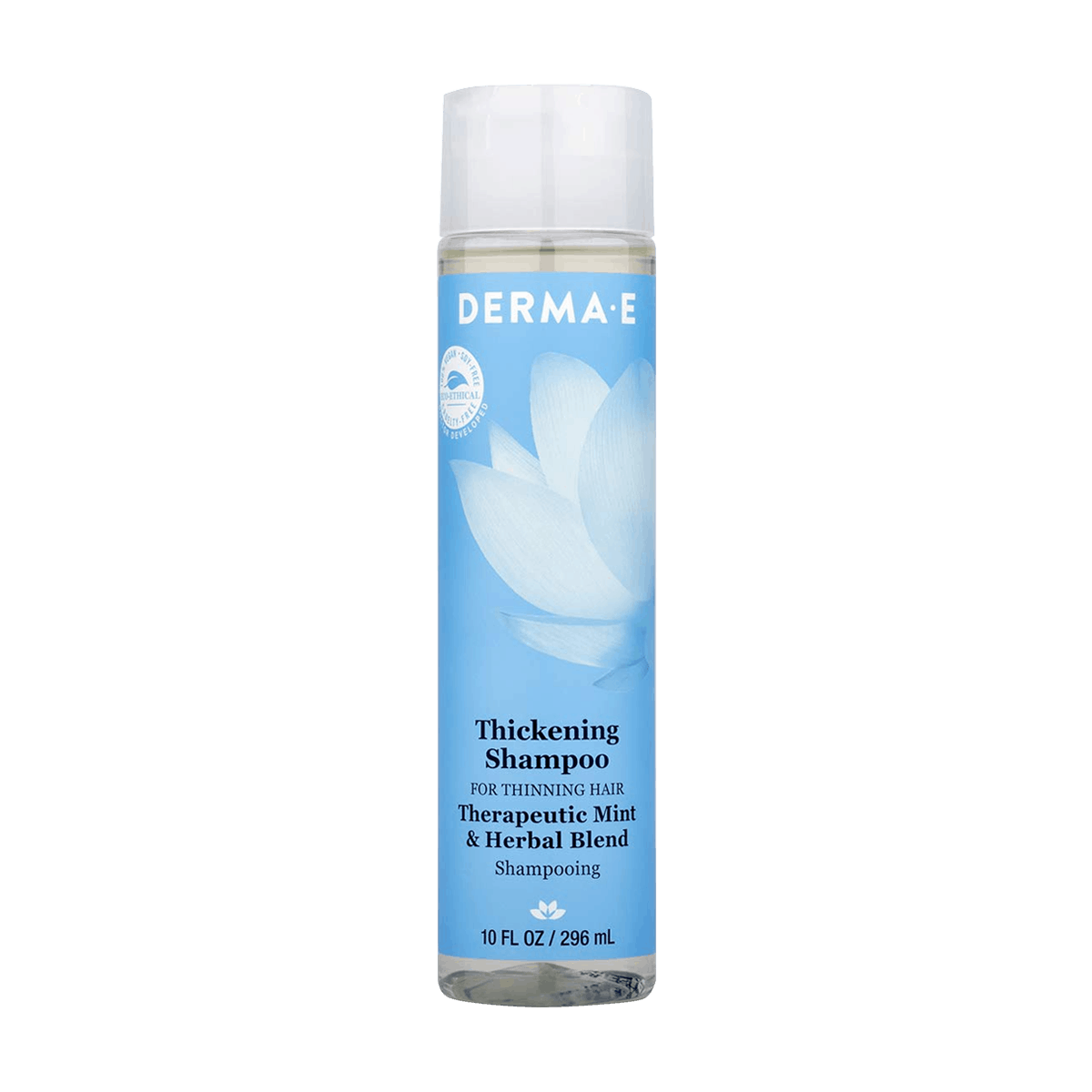The Best Natural Shampoo (20+ Shampoos Rated on Ingredients)

Over the past 2 weeks we researched 20+ of the most popular clean and organic shampoos on the market to see if their ingredients are as conscious as they claim.
There are a number of good reasons to consider the swap to a natural shampoo.
Shampoos have been available on the mass market since the 1920s, and traditionally have used synthetic surfactants, which can be damaging and drying to the hair. Other ingredients like concerning synthetic preservatives (parabens), silicones, and chemical fragrances are found in many conventional shampoos.
On the other hand, natural or organic shampoos replace these harsh chemicals with natural oils, plant extracts, and other natural ingredients. For many people, especially those with problem hair, they notice an improvement to their hair’s health after switching to a more natural shampoo.
Today we’ll be looking at:
- The ingredients to be aware of in conventional shampoos.
- Common problems people have when switching to natural shampoos.
- Ratings for 20+ of the most popular clean shampoo brands.
Ingredients of Concern in Conventional Shampoos
When looking for a natural shampoo, these are the ingredients to look out for.
Sulfates
Sulfates are chemical detergents that have been used in shampoos and conditioners for a very long time. They’re responsible for the smooth lathering effect you expect with your shampoo. They’re very effective at removing dirt and oil, but this comes at a price. They’re very harsh and can be damaging to the hair or scalp, especially if you have sensitive skin or allergies to sulfates.
Allergic reactions to sulfates seem to be on the rise, which is another good reason to avoid them. Symptoms like skin redness, rashes, swelling, itchiness, and hives are tell-tale signs that you might be allergic to sulfates.
The American Academy of Dermatology recommends avoiding sulfates for people suffering from rosacea, eczema, contact dermatitis, or sensitive skin.
There are two main types of sulfates to look out for in shampoo: sodium lauryl sulfate (SLS), and sodium laureth sulfate (SLES).
There used to be concern that sulfates were carcinogens. There seems to be no evidence that SLS is unsafe, not labeled a carcinogen by the International Agency for Research on Cancer (IARC); U.S. National Toxicology Program; California Proposition 65 list of carcinogens; U.S. Environmental Protection Agency; and the European Union.
However, studies have shown that SLS caused severe epidermal changes in animal lab tests, and was also a possible cause for hair loss in high concentrations.
A Common Natural Alternative: Cocamidopropyl Betaine
As an alternative to SLS and SLES, many manufacturers have turned to cocamidopropyl betaine. In fact, 12 out of 20 of the shampoos we looked at contained this ingredient. This ingredient is derived from coconut oil, but is highly processed.
Cocamidopropyl betaine is a known contact allergen, so if you have sensitive skin or are prone to contact dermatitis, this is something to be aware of.
Even though there is this risk, it’s still a much better alternative to SLS and SLES. You might find that shampoos without SLS or SLES don’t clean the hair quite as well, though. There’s a reason why those two ingredients are used, and it’s because they’re effective at cleaning the hair, even if they might do damage over time.
Silicones
If you’ve ever used a conventional shampoo and it left your hair feeling sleek, shiny and healthier than ever before, silicones may be the reason. It’s true—they’re effective at making the hair feel nice, but this also comes at a cost.
First of all, silicone is derived from petrochemicals, which in itself may be cause for some people to avoid them.
Silicones are occlusives, meaning they seal off the hair, trapping in moisture and making it feel more hydrated. The problem is that these silicones build up over time on the hair. Ironically, this can dry out the hair over time, as it becomes harder and harder to wash the silicones out of the hair.
In turn, the body can sometimes have one of two responses: getting dry and brittle because of the lack of moisture, or getting super greasy by producing more oil. The end result is hair that looks worse than ever, and it becomes a vicious cycle of using more products on the hair in an attempt to clean or revive it.
It’s best to avoid shampoos with silicones altogether.
Parabens
Any product with water needs to have a preservative to avoid the risk of mold or other pathogens forming.
Parabens are synthetic preservatives can be found in all kinds of beauty and personal care products. They’ve been linked to endocrine disruption and cancer, and these days there are safer alternatives.
There is a long list of parabens to look out for, but anything ending in “-paraben” should be avoided. This includes propylparaben, methylparaben, isobutylparaben, and more.
Fragrance
Another common ingredient in beauty and personal care is fragrance. The problem with fragrance is that it’s almost always formulated with a long list of hidden ingredients thanks to a pair of laws from the 60s and 70s that allow manufacturers to hide their fragrance ingredients as trade secrets.
Phthalates are often added to chemical fragrances because they give the scent a longer staying power. Phthalates are endocrine disruptors that are linked to reproductive issues in boys and men, and may have other yet unknown health impacts.
Fragrance sensitivity is on the rise, and since these fragrances are often made up from a long list of mystery chemicals, it’s almost impossible for someone with an allergic reaction to find out what exactly is causing it.
Some brands use natural ingredients in their fragrance formulas, namely essential oils. If this is the case, there’s a good chance that the fragrance is safer to use and doesn’t contain phthalates, but essential oils can still cause allergic reactions.
Common Problems When Switching to Natural Shampoo
Not Enough Lather
If you’re used to traditional shampoos that use SLS and SLES, you might be in for a surprise when you try a natural shampoo without these ingredients. SLS and SLES are lathering agents that can dry out the hair and scalp, and so they’re not used in natural shampoos.
A common complaint people have with natural shampoos is that they don’t lather enough.
The amount of lather doesn’t correspond to how well the shampoo is working, though. Even if it seems like the shampoo isn’t lathering enough, it’s still cleaning the hair of dirt and debris.
For this reason, people using natural shampoo for the first time tend to use too much product. As long as you’re scrubbing your hair properly, it’s cleaning your hair adequately even if there isn’t a ton of lather.
Hair Feels More Greasy
When you switch to a natural shampoo, your hair might feel more greasy for the first weeks (or even months).
Traditional shampoos are full of chemicals that strip the natural oils from the hair. This creates a cycle of stripping out oils, then using conditioner to add oils and moisture back to the hair.
Organic and natural shampoos don’t have these harsh stripping ingredients, so when switching to one for the first time, you might find that the hair feels—and looks—greasier and heavier than usual. This is because the body is still producing oils to balance out the stripping, and this will naturally make it feel greasier.
Over time, this will balance itself out, but be prepared to have your hair feel a little gross at first. If you stick it out, you’ll likely find that your hair is healthier and feels better than ever before.
Our Methodology
We researched the internet, online stores and social media for the most popular clean and natural shampoos.
Each ingredient in every product was researched and analyzed for safety based on available public research. Where possible, sources for information are included.
Products are ranked from best to worst with an internal score based on the ingredient rankings.
Below is our list of natural shampoo ratings. They’re rated on this scale:
– These products are the best of the best. They contain great ingredients, are non-toxic and are often the best choice for our environment.
– These products are typically quite good, but don’t go above and beyond like our best choices.
– These products are typically okay, but have some issues that make us unable to give them a “Good” rating. Often times they contain ingredients or materials that are questionable.
– These products typically have toxic ingredients or issues that make them dangerous or unsuitable to use. These products should typically be avoided.
Best
These shampoos are the best of the best in the world of natural and organic shampoos. They’re free of harsh chemicals, contain organic ingredients, and any of them are a great choice.
Captain Blankenship

This shampoo is made from mainly organic ingredients, none of which are on our list of ingredients to avoid. It has a light scent, from essential oils, and contains only two potential irritants, both of which are essential oils. For these reasons, we give it our top rating.
Ingredients
Potential irritants: 2*
Sudsatorium

This shampoo has an excellent list of ethically-sourced vegan ingredients and a light strawberry scent that doesn’t linger. It also contains no ingredients that are known to be potential irritants, making it a safe choice for those with sensitive skin. For all of these reasons, this shampoo gets a top rating.
Ingredients
Acure

This organic shampoo from Acure contains a long list of ingredients, but they’re all clean. It contains a large number of essential oils which can sometimes be irritating for those with sensitive skin.
It also comes in at a great price, and although it isn’t the cheapest shampoo we rated “Best”, it has the best ingredients for the value, and is our recommendation for the best budget-priced natural shampoo.
Ingredients
Potential irritants: 8*
Andalou Naturals

Andalou Naturals’ Argan Oil & Shea Shampoo has a clean list of organic ingredients and is scented with essential oils. It also comes in at a great price, making it a great budget purchase for a clean and natural shampoo.
This is the least expensive shampoo we rated “Best”, although we recommend the Acure shampoo over this one as it has more organic ingredients.
Ingredients
Potential irritants: 4*
Good
These natural shampoos are also a good choice, but don’t quite go above and beyond like the shampoos we rated “best”.
Shea Moisture

This shampoo from SheaMoisture contains a decent list of ingredients and comes in at an inexpensive price. We reviewed shampoos with better ingredients, and it’s important to note that it contains fragrance, with the scent coming from undisclosed essential oils. It’s not quite at the level of other shampoos we looked at, but still receives a “Good” rating.
Ingredients
Potential irritants: 2*
Auromere

This shampoo has a very simple list of ingredients, with Cocamidopropyl Betaine being the only iffy ingredient for its potential for causing contact dermatitis. However, this is a common ingredient in natural shampoos as an alternative to harsher sulfates and should only be a concern for those with very sensitive skin.
Ingredients
Potential irritants: 1*
Desert Essence

Dessert Essence’s Italian Red Grape shampoo is one of the original clean shampoos, coming to market more than 15 years ago.
One downside to the shampoo is that it has undisclosed fragrance, which is reported to be natural. Other than that, the list of ingredients is clean and has only a few total ingredients that may be unsuitable for those with sensitive skin.
Ingredients
Potential irritants: 3*
Avalon Organics

This shampoo has a good list of natural ingredients, and none that give us concern. The main ingredient is organic aloe, and it has a very mild natural scent.
Note that although this brand is called Avalon Organics, not all of the ingredients in this shampoo are organic.
Ingredients
Potential irritants: 6*
Innersense

The only ingredient on our iffy list is sodium benzoate, which is a preservative and generally shouldn’t be a concern. Other than that, there are no other ingredients of concern, and we give this product a rating of “Good”.
Ingredients
Potential irritants: 5*
Sukin

This natural shampoo from Sukin gets a rating of “Good”. It does contain a substantial number of potential irritants, most of which are essential oils, and should only be a concern for those with sensitive skin. It comes at a very affordable price, too.
Ingredients
Potential irritants: 7*
Rahua

This shampoo does contain undisclosed natural fragrance, and we would prefer transparency with all ingredients. That issue aside, the product contains a good list of ingredients and you can feel safe using it.
Ingredients
Potential irritants: 3*
Ethique

This solid shampoo contains behentrimonium methosulfate, which receives an “iffy” rating because it was found to have potential reproductive impacts in animal studies. However, since this is a shampoo, this should not be a concern.
This shampoo also contains undisclosed natural fragrance, which can be a concern if you have sensitive skin. All factors considered, this shampoo receives a “Good” rating.
Ingredients
Potential irritants: 6*
EVOLVh

This natural shampoo has a clean list of ingredients, fragranced with essential oils and having a pleasant lemon scent. For its clean list of ingredients, we give it a Good rating.
The ingredient comfrey is on our list of iffy ingredients, but is not a concern in a shampoo, because comfrey is only toxic if ingested.
Ingredients
Potential irritants: 2*
John Masters Organics

Peppermint oil is rated iffy because it acts as a penetration enhancer, causing other ingredients to more easily absorb into the skin. However, in a product that otherwise has clean ingredients, this is not a concern.
Ingredients
Potential irritants: 5*
Iffy
A total of 5 of the natural shampoos we looked at received an iffy rating. These shampoos have issues that make us unable to recommend them.
Derma E

This shampoo contains polysorbate-20, which has the potential of being contaminated with 1,4-dioxane and ethylene oxide, both of which are possible human carcinogens. For this reason, we give this product a rating of “iffy”.
Ingredients
Potential irritants: 6*
Earth Science

This shampoo has undisclosed fragrance, but the brand claims that it is “natural fruit-blossom fragrance”. However, because we can’t verify this, we have to give it a rating of “Iffy”.
Ingredients
Potential irritants: 1*
Giovanni

The main reason why we can’t recommend this shampoo is because it contains polysorbate-20, which can be contaminated with 1,4-dioxane and ethylene oxide, both thought to be carcinogens.
Ingredients
Potential irritants: 3*
Yes To

This shampoo from Yes To has a generally good list of ingredients. However, it contains undisclosed fragrance. We were unable to determine if the fragrance is natural or not, and because we can’t get any information on it, we have to give it an iffy rating.
Ingredients
Potential irritants: 8*
Live Clean

While this shampoo has a good list of ingredients, it contains undisclosed fragrance. We were unable to determine if this fragrance is natural or chemical, and although based on the brand it’s most likely a natural fragrance, we cannot give it a good rating for this reason.
Ingredients
Potential irritants: 6*
Bad
Only one of the natural shampoos we looked at received a “bad” rating, because it contains undisclosed chemical fragrance.
Love Beauty and Planet

Love Beauty and Planet is featured on our list of greenwashing brands, and this shampoo is a good example of why.
It contains harsh sulfate SLS and undisclosed fragrance, two ingredients that we would recommend avoiding. For this reason, this product receives a rating of “Bad”.
Ingredients
Potential irritants: 3*








